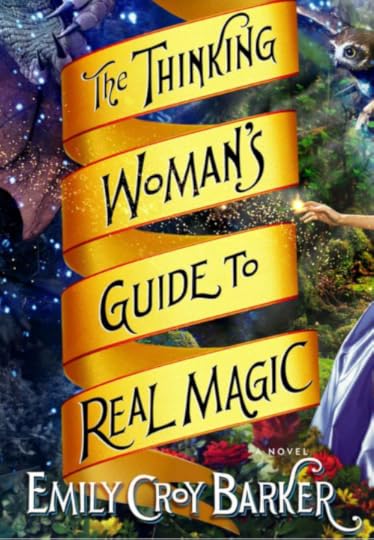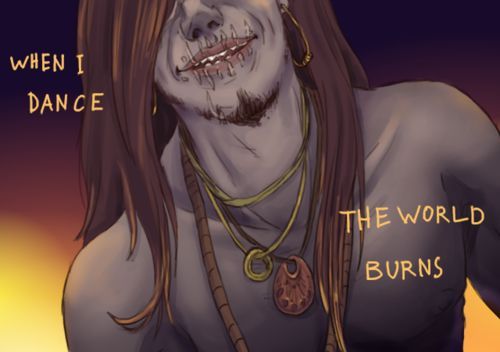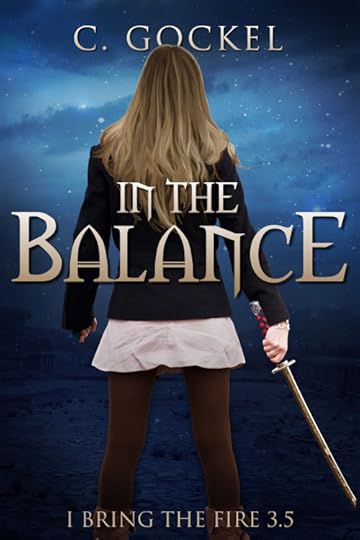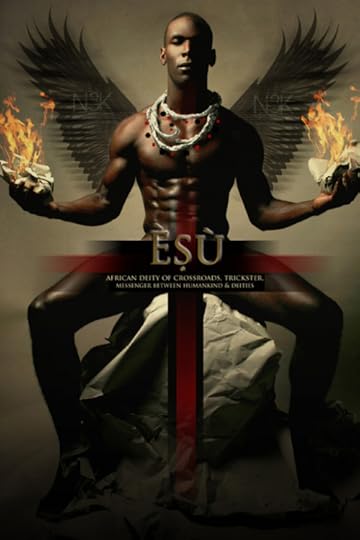C. Gockel's Blog, page 55
July 11, 2015
cgockel:
Book Review: The Thinking Woman’s Guide to Real Magic...

Book Review: The Thinking Woman’s Guide to Real Magic by Emily Croy Barker
I never review books that I don’t think are worth reading … that said, I confess, I didn’t buy this book, I tested out the Chicago Public Library’s ebook loaning system instead. This book was published by Penguin and it is expensive: $9.99 when I last checked Amazon. I have a number of reservations with buying an ebook for that much–number one on that list is that you don’t own ebooks, you merely lease them. It’s a *permanent* lease arrangement, but still, you cannot resell them, or even donate them to charity.
With that being said–on with the review.
This isn’t an action packed adventure story, or a bodice ripping paranormal romance, although there is romance and adventure. This is a plunge into another world, a world that is medieval in outlook and without modern technology. The technology that does exist is based on magic not mathematics and machines. Nora, the heroine in the story does come from our world though, which I find more interesting because she is able to compare and contrast the new world with the modern and medieval Western World.
A quick side note: I know that a lot of people complain that fantasy authors that cast men as the dominant gender in fantasy worlds as “lazy”–if you’re one of those people, you won’t like this book. I’m not one of those people, and I found Nora’s struggles with the male dominated status quo in the magical world to be interesting and believable (I’m not sure that a woman raised in such a society would be such a firebrand, or would be able to do the things Nora does as quickly as she does–learning the local language for instance). It definitely gave more conflict to the story.
One thing I really liked about the story is that Nora is smart, and though a little dim when it comes to romance, she is, overall, fairly mature. The author did not make her a 28 year old that acts like she is 16 (for the most part). Over the past few weeks I’ve been picking up books left and right and I’ve been having trouble finding one where the heroine isn’t written like a 16 year old (which is fine, when the heroine actually is 16, but only then!) Nora is well educated, she was a grad student studying medieval poetry when she is sucked into her new reality. She likes reading, studying, and acquiring information that might be useless just for the sake of acquiring that information. Books are her refuge. I can identify with that!
Another thing I really liked about this story was that Nora doesn’t secretly have fairy or witch ancestors. She comes to her magic through natural curiosity and hard work. I know, I know, hero arcs demand that the hero find a magical sword or discover their dad is Darth Vader, but I really like it when the “magic” comes through effort rather than simple luck. (You may have picked that up from Amy Lewis’s struggles and eventual triumph in my I Bring the Fire series … also available on Scribd, Oyster, and Overdrive, the public library ebook loaning program.)
A huge strength of the story, and what makes it engaging and a page turner (or screen swiper in my case) is the language that Ms. Barker uses. She is a wordsmith, and even when Nora is pulling turnips you are pulled along by the strength of her language alone (and the pulling turnips, and chopping vegetables scenes do add a richness to the story–it sounds boring, but with Ms. Barker’s writing style isn’t–and the scenes highlight and make believable Nora’s desperation to escape into the books on her host’s shelf, even though she can’t at first read them).
I do have some quibbles with the story. I didn’t always like Nora, and sometimes her romantic maturity did not exist. Some of it was to set up the cliffhanger at the end of the book–but I think Ms. Barker could have arrived at that cliffhanger in a more logical, believable way.
Which brings up the other issue … the cliffhanger. Yes, I use them. But for $9.99 I would have been mad if I had purchased the book. I may pay $9.99 for the sequel, since Thinking Woman is long, and I do want authors to be paid … but $9.99 for an unresolved ending … eh. And an ending that could have been handled better (see above commentary about her decision at the end could have been LOGICAL instead of a parody of Elizabeth Bennet in Pride and Prejudice).
Anyway, if you haven’t tried your library’s ebook loaning, Thinking Woman is an excellent book to practice on. I would highly recommend it–you can even read on paperwhite e-Ink devices. I thought it would be difficult, but it was incredibly easy.
Or you can buy it from Amazon in ebook or paperback format.
Hat tip to elementarydata for recommending this book to me.
July 10, 2015
Kindle Unlimited 2.0 (a.k.a. The Great Author Freakout of 2015)
It’s been awhile since I posted about the business of writing, but there have been some huge shakeups in the retails side of ebooks, and I felt like I should comment.
First a little bit about Kindle Unlimited. Kindle Unlimited is an ebook subscription service that allows subscribers to read as many ebooks as they can for $9.99 a month.
The caveat for readers? Not every ebook on Amazon is in the program.
The caveat for writers? There are two …
The biggest is that to be in Kindle Unlimited you must be exclusive to Amazon. That means no iBooks, no Nook, no Google Play Books, no Kobo, no Scribd, no Oyster, no Overdrive. Zilch. Nada. All of your eggs are in the Amazon basket.
The second biggest is that the payout for borrows under the KU model is not stable. It varies month-to-month based on the size of a pot that Amazon divies up to all participating authors based on number of borrows. Theoretically, this pot should be paid by subscription fees. In reality, it is not. To keep the payout for borrows reasonable Amazon has been pumping cash into the pot every month.
So how are borrow payments determined? Herein lies the big change. Since last August borrow payouts were the same whether an author had written a 350 page novel or a 10 pamphlet. The payout for both typically hovered around $1.33 a month. (To put this into perspective, a $3.99 book on Amazon generates approximately $2.75 in income. So a borrow would be less than half the usual take home). This had the predictable fallout: writers of longer works started to flee the program–in particular popular writers started to flee. Customers complained that Kindle Unlimited was “Kindle Limited”. So Amazon tried to sweeten things for popular writers by creating “All Star Bonuses.” These were given out each month to people with the most borrows. The problem was, even with these bonuses, for a lot of popular writers of longer work–Rosalind James and H.M. Ward for instance–even with the All Star Bonuses their income tumbled. The All Star Bonuses simply weren’t enough to cover the lost sales.
This version of Kindle Unlimited was GREAT for writers of short stories and novellas. A novella that might have been priced at 99¢ and earning 35¢ a sale was suddenly earning $1.33 per borrow. A lot of short story writers in Kindle Unlimited started making the sale price of their 50 or less page stories $2.99–higher than it would have been pre-KU–so that they would look like a better bargain to KU borrowers. They lost sales that way, but they were making it up on the borrow payments. Some writers of longer works started breaking up their stories into 100 page installments to adjust.
This still left a problem for Amazon. The popular writers weren’t coming back, and as much as readers were borrowing shorter works readers time after time say they prefer longer works–and borrowing and buying habits bear this out.
So last week Amazon changed the way borrow payouts are calculated. Instead of being a flat amount no matter how long the book they changed it to an amount calculated per page read (with some exceptions for non-fiction and children’s books.)
This helps fix some of KU’s problems. With the unlimited borrowing and returning, some authors were paying services to download their books, open them up to 10% (the minimum needed for payout), and collecting the royalties for those fake borrows AND reaping the benefit of increased ranking.
Also, novel writers are coming back to the fold. Rosalind James came back to KU, and other authors who’ve been vocal proponents of wide distribution have entered the KU pool for the first time.
Are there any losers? Yes, there are a lot of people taking the hit. Over the past year a lot of writers adapted to KU by writing short 50-100 page shorts and novellas. Because they had more to borrow they were more likely to get all star bonuses–now with pages read being the benchmark those bonuses will likely go away. And they’re going to make a lot less per borrow too. Currently, the payout has been calculated at about a half a cent per page. So 100 pages at that rate will be 50¢, 50 pages at that rate is going to be 25¢ … for the writers of really short novellas, that is less than a ¼ of what they were making before. Some people had quit their jobs based on the old payout system. Now they’re in trouble.
Add to this big news, Scribd, a fairly consistent source of income for indie writers, quite suddenly removed all indie romance books. My indie romance friends were used to making $300-$500 / month on Scribd. Scribd, unlike KU, didn’t require exclusivity and made payments based on 60% of list price. Since it was based on list, and readers were insulated from real prices, a novella or short at $2.99 did very well there.
And … Nook seems to be failing. Personally, I’ve seen my sales there whither. It used to be my second biggest retailer after ‘zon with about 10 sales a day on just six books. Now I have eight books and my daily sale average has dropped to 6 sales a day. Other sites are doing better. My Gods & Mortals box set has been featured by iBooks, and that has helped a lot. But that was pure luck. iBooks isn’t as well supported by advertisers, and as soon as G&M starts to slide over there there isn’t an easy way to push it back up. Kobo and Google are growing, but painfully slowly, and still have less support from advertisers.
So, a lot of writers are feeling the urge to jump ship and go “all in” on Amazon.
I have a new trilogy I’ll be publishing in a couple of months (Probably in September or October. For a new release discount sign up for my newsletter!) I am definitely putting it in KU because of these new changes. Will I put my I Bring the Fire series into KU? I’m not sure.
On a philosophical level, I like that all of my books are available to libraries via Overdrive. It makes me happy that there is a way to read my books completely free.
On a purely practical level, as KU becomes more popular for writers of longer works, there will be more competition, and the payout levels may go down (or Amazon may decide to prop them up as a loss leader.)
My guess is starting from my next trilogy, I will try to keep something in KU at all times. It is just another funnel, a way to increase visibility and get readers to find me. Yes, KU subscribers to buy books–a surprising number of my fans are in KU. But I may also try to keep my toes in the waters of other vendors too, that way I have the most flexibility and don’t depend on Amazon entirely.
Thank you for reading! If you enjoyed this post and found it useful, please consider downloading I Bring the Fire Part One (A Loki Story) the first book in my series. It’s FREE everywhere: Amazon, iBooks, Nook, Kobo, GooglePlay, Smashwords, Scribd, and Oyster.
July 9, 2015
camwyn:
thecuckoohaslanded:
exhalea:
“A friend took this pic...

“A friend took this pic in Arizona USA. The meteorologists don’t have a name for it. Seems to be high energy to be in a rainbow and a tornado.”
Holy fucking shit
TORGAYDO
“SHIT! SHIT! SHIT! WE MISSED SOMETHING, IT’S NOT FIXED YET! HEIMDALL, CLOSE THE BRIDGE RIGHT THIS INSTANT!!!”
strandedinmidgard:
lokeancupcakes:
Month for Loki - Day 7This...

Month for Loki - Day 7This is one of my favorite pictures of Him.
I like it’s His smile. I love His smile.
Hail Loki, Scar Lipped
Hail Loki, Breaker of Worlds
Hail Loki, Fire of Rebirth
Why, thanks.
July 3, 2015
Tentative new cover for In the Balance, I Bring the Fire Part...

Tentative new cover for In the Balance, I Bring the Fire Part 3.5
First in series is free on Amazon, iBooks, Nook, GooglePlay, & Kobo
July 1, 2015
Esu African Trickster God - by James C. Lewis (Click for more...

Esu African Trickster God - by James C. Lewis
(Click for more amazing portraits of African Gods and Goddesses)
June 26, 2015
thetalkingpoltergeist:
You’re making me nervous.
Looks mythic...
June 25, 2015
reginahoer:
Knowth on Flickr.Brú na Bóinne (Irish: Palace of...

Knowth on Flickr.
Brú na Bóinne (Irish: Palace of the Boyne) is a World Heritage Site in County Meath, Ireland and is the largest and one of the most important prehistoric megalithic sites in Europe.
The site is a complex of Neolithic chamber tombs, standing stones, henges and other prehistoric enclosures, some dating from as early as 35th century BC - 32nd century BC. The site predates the Egyptian pyramids and was built with sophistication and a knowledge of science and astronomy, which is most evident in the passage grave of Newgrange. The site is often referred to as the “Bend of the Boyne” and this is often (incorrectly) taken to be a translation of Brú na Bóinne (Palace of the Boyne).
The site covers 780 ha and contains around 40 passage graves, as well as other prehistoric sites and later features. The majority of the monuments are concentrated on the north side of the river. The most well-known sites within Brú na Bóinne are the impressive passage graves of Newgrange, Knowth and Dowth, all famous for their significant collections of megalithic art. Each stands on a ridge within the river bend and two of the tombs, Knowth and Newgrange, appear to contain stones re-used from an earlier monument at the site. There is no in situ evidence for earlier activity at the site, save for the spotfinds of flint tools left by Mesolithic hunters.
more here : en.wikipedia.org/wiki/Br%C3%BA_na_B%C...
© Regina Hoer
June 24, 2015
BOOK SALE ALERT! Christopher Moore’s A Dirty Job is on...

BOOK SALE ALERT! Christopher Moore’s A Dirty Job is on sale for $1.99. I really enjoyed this book when I read it years ago (before I had a Kindle–Gasp! It was the dark ages … Literally, I had a very dim lamp on my bedside table.)
This was a cheerfully written, fun book, although I *DID* guess the ending. I read all of it even knowing what would happen, just because Moore’s style is so engaging).
Anywho, it’s been too long to write a proper review, but I will recommend it. Especially since the Kindle version is on sale for $1.99 right now on Amazon.
Also, I checked, and it is also available on Oyster, Scribd, and Overdrive. Have fun everyone!
The New World of Publishing: The Real Price of Traditional Publishing |
Read the article for an interesting look at traditionally published vs. indie published earnings.
I never considered getting traditionally published. When I started writing I was working and had small children (still have the children, not working as much, thankfully). From what I gathered, shopping for an agent was another part-time job–it wouldn’t have left anytime for writing.
Despite the fact that I am NOWHERE near a best seller, I’ve made a lot more than a traditionally published author would. There was a great article by an award winning best-selling fantasy author a while back … she’s traditionally published and the size of her contract was pitiful. I made much more *writing* than she did.Some things I would love about being trad published … editing … editing is a big one. But then again, I’ve read of authors who’ve come under editors who hated their style and would sit on their books without commenting on them. So, that might be over rated too.
I might take a publishing contract some day. If I was going to write a single, standalone novel I’d most definitely shop for an agent. Since I’ve got a platform of my own, and some (very) modest success, they’d be more likely to take me, too.





